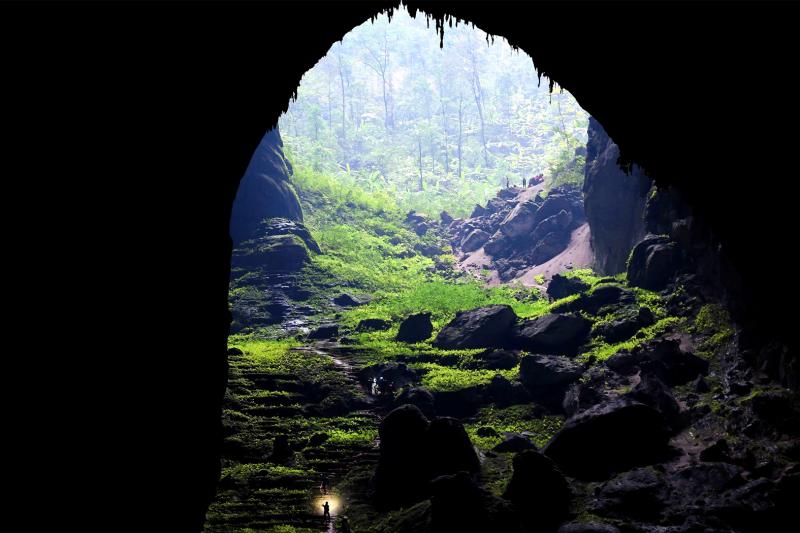Vast rock formations the size of multistory buildings loomed above Ho Minh Phuc as he picked a path through the gloom inside the world’s largest cave.
Phuc, who once earned a living through illegal logging, is a porter for the small tour groups that explore Vietnam’s Son Doong — a cave so large it has its own ecosystem and weather patterns.
Home to flying foxes and a 70m rock formation resembling a dog’s paw, the cave is an otherworldly wonder that has reshaped the lives of the surrounding community since it opened for boutique tourism in 2013.

Photo: AFP
Trapped in poverty, young men like Phuc once had little choice but to forage in the depths of Phong Nha-Ke Bang National Park — the World Heritage site where Son Doong lies. There they searched for precious agarwood, a hugely sought-after material known as “the wood of the gods” and widely used for incense.
Others eked out a living from hunting endangered civets and porcupines in the forest.
“We had to do all we could to avoid the forest rangers,” 35-year-old Phuc told reporters. “We did nothing good for nature.”
Son Doong in central Quang Binh Province was first discovered by local forager Ho Khanh in 1991, when he stumbled upon an opening in a limestone cliff and heard the sounds of a river deep inside.
However, after returning home through the thick surrounding jungle, Khanh forgot where the hidden entrance lay, and it stayed lost for another two decades.
When he eventually led a team of British experts back there in 2009, the team found it had the largest cross-section of any cave anywhere on the planet.
It is large enough to house the 40-floor skyscrapers of an entire New York City block, according to adventure tour company Oxalis, which guides visitors into the caves.
When Son Doong was opened to tourists four years later, the lives of Khanh and hundreds of locals changed forever.
They soon became porters and guides, and opened their homes to guests wanting a bed for the night.
“Some became rich with logging, but most lived a very hard life,” Khanh, now 52, said of the time before the cave was opened to the outside world.
“When tour companies came in, I told the youngsters their first duty was to protect the environment so as to benefit not just ourselves, but also our children ... so life can improve,” he said.
Before the COVID-19 pandemic, Vietnam’s tourism industry was booming, but the communist country has come under fire for failing to preserve landscapes as it rapidly expands the sector.
The area has so far largely stayed clear of the mass tourism model used in other Vietnamese holiday hotspots such as Halong Bay, where cruise ships have spewed sewage into once-pristine waters.
With only one company given permission to operate in each of the key caves, there is an incentive to protect them, with numbers of visitors limited and prices kept high.
However, challenges lie ahead, UNESCO has said.
Poaching remains among the national park’s “most serious threats,” it said in a report that also raised concerns over a proposal to build a cable car to nearby Hang En cave.
Logging has also not disappeared — 18 people were sentenced last year for cutting down trees in the national park.
As COVID-19 swept the globe, locals catering to international travelers have struggled.
Khanh said his guests are 90 percent down since the pandemic began.
However, Son Doong has weathered the crisis fairly well overall, thanks to a boost in visitors among Vietnam’s fast-growing middle class.
The high-end tourism model of the caves — which provides about 500 jobs for the local community — has begun to attract interest in other areas, Oxalis said.
However, industry professionals are skeptical that the pandemic could spark a change in direction across the country.
Vietnam’s tourism industry has done “some very good policymaking, but they’ve generally ignored their own policies,” said Peter Burns, a tourism planning consultant and professor who worked on a five-year EU-funded sustainable tourism project in Vietnam.
Despite strong environmental protections in place, “they tend to build stuff anyway,” he said, pointing to the spread of high-rise hotels in Halong Bay.
For Phuc, it is crucial that the pandemic does not lead to a similar outcome in Son Doong.
“If we expanded into mass tourism, it would of course harm the natural scenery,” he said. “That would be terrible.”

Kehinde Sanni spends his days smoothing out dents and repainting scratched bumpers in a modest autobody shop in Lagos. He has never left Nigeria, yet he speaks glowingly of Burkina Faso military leader Ibrahim Traore. “Nigeria needs someone like Ibrahim Traore of Burkina Faso. He is doing well for his country,” Sanni said. His admiration is shaped by a steady stream of viral videos, memes and social media posts — many misleading or outright false — portraying Traore as a fearless reformer who defied Western powers and reclaimed his country’s dignity. The Burkinabe strongman swept into power following a coup in September 2022

TRUMP EFFECT: The win capped one of the most dramatic turnarounds in Canadian political history after the Conservatives had led the Liberals by more than 20 points Canadian Prime Minister Mark Carney yesterday pledged to win US President Donald Trump’s trade war after winning Canada’s election and leading his Liberal Party to another term in power. Following a campaign dominated by Trump’s tariffs and annexation threats, Carney promised to chart “a new path forward” in a world “fundamentally changed” by a US that is newly hostile to free trade. “We are over the shock of the American betrayal, but we should never forget the lessons,” said Carney, who led the central banks of Canada and the UK before entering politics earlier this year. “We will win this trade war and

‘FRAGMENTING’: British politics have for a long time been dominated by the Labor Party and the Tories, but polls suggest that Reform now poses a significant challenge Hard-right upstarts Reform UK snatched a parliamentary seat from British Prime Minister Keir Starmer’s Labor Party yesterday in local elections that dealt a blow to the UK’s two establishment parties. Reform, led by anti-immigrant firebrand Nigel Farage, won the by-election in Runcorn and Helsby in northwest England by just six votes, as it picked up gains in other localities, including one mayoralty. The group’s strong showing continues momentum it built up at last year’s general election and appears to confirm a trend that the UK is entering an era of multi-party politics. “For the movement, for the party it’s a very, very big

SUPPORT: The Australian prime minister promised to back Kyiv against Russia’s invasion, saying: ‘That’s my government’s position. It was yesterday. It still is’ Left-leaning Australian Prime Minister Anthony Albanese yesterday basked in his landslide election win, promising a “disciplined, orderly” government to confront cost-of-living pain and tariff turmoil. People clapped as the 62-year-old and his fiancee, Jodie Haydon, who visited his old inner Sydney haunt, Cafe Italia, surrounded by a crowd of jostling photographers and journalists. Albanese’s Labor Party is on course to win at least 83 seats in the 150-member parliament, partial results showed. Opposition leader Peter Dutton’s conservative Liberal-National coalition had just 38 seats, and other parties 12. Another 17 seats were still in doubt. “We will be a disciplined, orderly